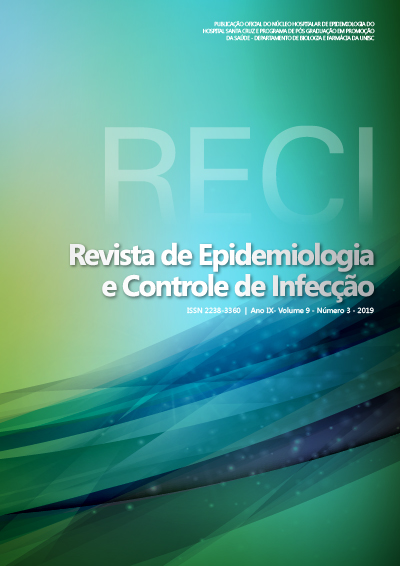Evaluation of contamination by Acinetobacter spp. in an intensive care unit
DOI:
https://doi.org/10.17058/reci.v9i3.12510Keywords:
Contamination. Infection Control. Acinetobacter. Acinetobacter baumannii. Intensive Care Units.Abstract
Background and Objectives: The clinical relevance of Healthcare Associated Infections caused by Acinetobacter spp. and the confirmation of the existence of strains with multi-resistance in the hospital environment show the need to know better the epidemiology of these infections, in order to help the implantation of more effective measures of prevention and control of this pathogen. The objective of this study was to evaluate the phenotypic diversity and the sensitivity profile of Acinetobacter spp. isolated from inpatients, hands of professionals and inanimate surfaces in an Intensive Care Unit of a public hospital in the southeast region of the state of Pará. Methods: The professionals’ hands and surfaces were collected using swabs moistened in sterile saline and rubbed by rolling. Data analysis was performed using descriptive statistics techniques using absolute and percentage distributions. Results: Of the 163 samples collected, 87 (53.4%) came from the surfaces, 47 (28.8%) from the patients and 29 (17.8%) from the hands of professionals. Growth of Gram-negative bacteria was observed in 28%, being Acinetobacter baumannii the most prevalent strain, present in the clinical isolates of patients and on the surfaces after the cleaning process. A. baumannii was resistant to all antimicrobials tested. Conclusion: A. baumannii was the only species of the genus Acinetobacter to be found, being such strains resistant to all antibiotics tested.Downloads
Downloads
Published
How to Cite
Issue
Section
License
The author must state that the paper is original (has not been published previously), not infringing any copyright or other ownership right involving third parties. Once the paper is submitted, the Journal reserves the right to make normative changes, such as spelling and grammar, in order to maintain the language standard, but respecting the author’s style. The published papers become ownership of RECI, considering that all the opinions expressed by the authors are their responsibility. Because we are an open access journal, we allow free use of articles in educational and scientific applications provided the source is cited under the Creative Commons CC-BY license.


